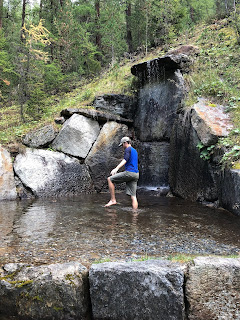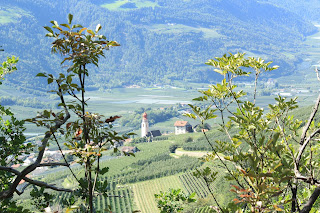Sulden sits in the lap of South Tyrol's highest mountain, Ortler, and charms with yak-filled meadows, a healthy moderate altitude and panoramic walks to invigorate the senses.
The next day, rain is still tumbling. Pitter patter. But we venture out, walking past the yaks and Sulden's small collection of ski-resort-essential sports shops and hotels until we climb into woodland on the Kulturpanoramaweg, which leads to a suspension bridge crossing a billowing waterfall. The rocky terrain is peppered with rosebay willowherb, and the Arolla pines, larches and chestnut trees are bustling with red and black squirrels and nutcrackers busily seeking seeds. En-route there are different activities to help connect to nature - wooden chimes, a telescope and a barefoot path. It's too wet for that today, but the air alone feels beautifully good: it's reported that Sulden's moderate altitude of around 2,000 metres above sea level helps the body build more blood cells and can support the thyroid by activating the metabolism.
Overnight, the cloud loosens to reveal an irresistibly gorgeous morning: Ortler has been dusted in snow, its bookshelf-like ridges of mighty dolomite rock polished by sunlight. But to ease our acclimatisation, we drive down into the Vinschgau valley, where blooming orchards are severed by the aquamarine River Etsch, for a tour of medieval Glurns, South Tyrol's smallest city. A once important customs post, it is charmingly enclosed by turreted walls that have at times protected it from battles and floods, and features artfully converted barns, white-painted archways and stocky farmhouses with deep sunken windows. In 1519, it held a remarkable trial, in which local farmers called for the removal of the city's mice, but the latter were granted a lawyer who fought for them to be awarded a safe retreat. Later, we munch locally made Palabirnenbrot (spice bread that is juicy with the region's oldest variety of pears) in the shade of trees close to Lichtenberg, a 13th century castle built by the counts of Tyrol. It is a grand golden ruin, with the remains of elaborate frescoes and halls that would once have been filled with Minnesang.
The mountains around Sulden are excellent for high-altitude walking, though a little limited for easier, non-mountaineering type routes. We nevertheless find a slew of favourites. One day we walk from the Langenstein chair lift station across moraine beneath the North Face of Ortler to the Taberettahütte (2556m), where we enjoy an Apfelstrudel on the sun-baked terrace. All around, rocky flanks are ablaze with Alpine bearberry, its leaves glowing cranberry like hot embers. In every distance, mountains slumber in a blue haze. High above, the Julius Peyer Hut, which marks the start of the final climb to Ortler's summit, looks like the battlements of a Cathar Castle amid rocky towers.
Then there is Rosimboden, on the other side of the valley. A basin of pure gushing streams, whistling marmots and bright rosebay willowherb, it overlooks the theatre of Ortler, Zebru and Königsspitz - a trio of summits as spectacular as Switzerland's Jungfraujoch. All three are almost 4,000 metres high, and have glaciers tumbling down their steely dolomite flanks like scarves. Tim alone braves the climb to the Düsseldorfer Hut (2,721m) and higher to the summit of Hinteres Schöneck (3,128m). I, meanwhile, meditate on the mountains: the grass beside our terrace dances in the breeze; cow bells jangle among the Arolla pines; the sun gilds Ortler, while loose cloud tangles and releases the summit like a whimsy silk tie caught in a breeze. Particularly charming is that our friendly landlady, Hanna, comes by later that day with some homemade apricot cake - yum.
Back in the mountains the following day, we view Ortler from Trafoi. The summit's appearance is no less mighty - and perhaps even more so - from this time-worn village in the parallel valley to Sulden on the road that switchbacks to the Stilfserjoch. Ortler bookends one extreme of an immense flank of Alpine wall made up of glaciers between sheets of steel grey, so distant, cold and impenetrable. It is an 18-minute journey by chair lift to the Furkel Hut, where we start our walk along a stretch of the Italian Front from World War One. Pillbox remains stand silhouetted against the magnificent mountain wallpaper. We continue towards Stilfser Alm, and find ourselves amid an end-of-summer descent of cows from the high Alpine pastures (Almabtrieb), then later sit on the terrace at Furkel Hut watching what may be a bearded vulture - they were recently reintroduced to the National Park - gliding on the eddies.
Another new perspective on Ortler comes on the shores of Haidersee in Obervinschgau. Seen from this wide green plateau, the mighty summit rises in a sky churning like concrete. It's superbly tranquil here, as we stroll the lake's parametres on boardwalks, though the air feels heavy with imminent rain. Great-crested grebes dip and dive on the petrol-blue water, which has a silver sheen like sealskin. We spent the morning in Mals - famous for its five towers dating from the 11th century and, like many of the towns in the valley, charmingly untouristy with workaday cafes and pretty farmhouse homes in place of twee eateries and boutique hotels - then later continue to Reschensee, a reservoir created in the 1950s by drowning Glauns. All that remains of the village is its church spire, protruding from the bright turquoise depths in an almost optical illusion, in equal parts eerie and beautiful.
Our holiday ends with a fantastic visit to a Schafabtrieb in nearby Stilfs, a tangle of bone-white farmhouses dangling from the steep valley. An event held to celebrate the bringing down of the sheep from the high Alpine pastures, the Abtrieb is an important part of local culture. In a woodland clearing, we find pens full of sheep, jumping, tumbling and jostling; locals with their elbows crooked on the fences, watching the goings-on as if at market day; and farmers amid the woolly masses, selecting one at a time for shearing.
"Ice is a living thing: pack ice drifts, glaciers flow, icebergs melt, crevasses open, avalanches descend and ice falls cascade." MMM Ortles






































































